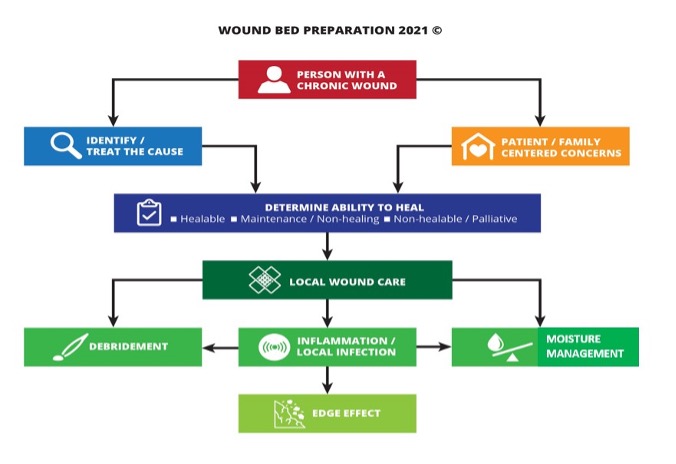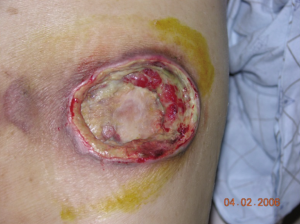Chapter 15: The Edge Effect in Chronic Wound Care
Edge Effect and Adjunctive Therapies
Authors:
- Haya Homsi, MD, MPH
- Muskaan Sachdeva, MD
- Asfandyar Mufti, MD, MScCH
- R. Gary Sibbald, BSc. Md. M.Ed., D.SC (Hon), FRCPC (Med)(Derm), FAAD, MAPWCA, JM
Learning Objectives
- Define edge effect in chronic wounds
- Explore different adjunctive therapies for wound care
Introduction
This chapter focuses on the edge effect as it relates to chronic wound care within the Wound Bed Preparation paradigm. Wounds that are present for six weeks or more are considered chronic. When wounds are determined to be healable but stalled, this is an opportune time for adjunctive therapy considerations. Patients and their circle of care engagement will improve treatment decisions for edge effect. The geographical practice setting and resources will impact the availability of edge effect interventions. Often, adjunctive therapies with excellent scientific data may not have cost effective application for everyday practice.
It should be emphasized that the following steps need to be completed prior to the use of adjunctive therapies:
- Accurate identification and treatment of the wound cause
- Determination of healable wound that is stalled
- Optimization of patient-centered concerns
- Appropriate steps for optimal Debridement, Infection/Inflammation, Moisture management (DIM)
If all the factors are corrected in a healable wound, active adjunctive therapies may be considered. This edge effect is an important last step of the Wound Bed Preparation (WBP) paradigm. See Figure 1.
Figure 1. Wound Bed Preparation Algorithm 2021

Edge Effect
Wound healing involves the advancing of the purple-pink epithelium at the wound periphery into the mature granulation base that forms a tapered edge, with the goal of ultimately covering the wound with a new epithelial layer (Woo, Ayello, and Sibbald 2007). A healing wound with tapered edges is like the shore of a sandy beach. Edge effect refers to the steep cliff-like epidermal edge that occurs due to the failure of the epithelial migration across a firm, pink and level granulation base that would result in delayed wound healing (Figure 2; (Woo, Ayello, and Sibbald 2007).
Many edge–effect therapies support the addition of missing components including growth factors, fibroblasts, epithelial cells or matrix components. There are several adjunctive therapies available for chronic stalled but healable wounds that are discussed in this chapter.
Figure 2: Edge Effect (Woo, Ayello, and Sibbald 2007)

This picture illustrates a wound with a cliff-like edge. There is surface yellow eschar, red friable tissue and slough that will contribute to the lack of healthy granulation tissue that has not reached the surrounding edges of the skin. The process of re-epithelialization is delayed.

